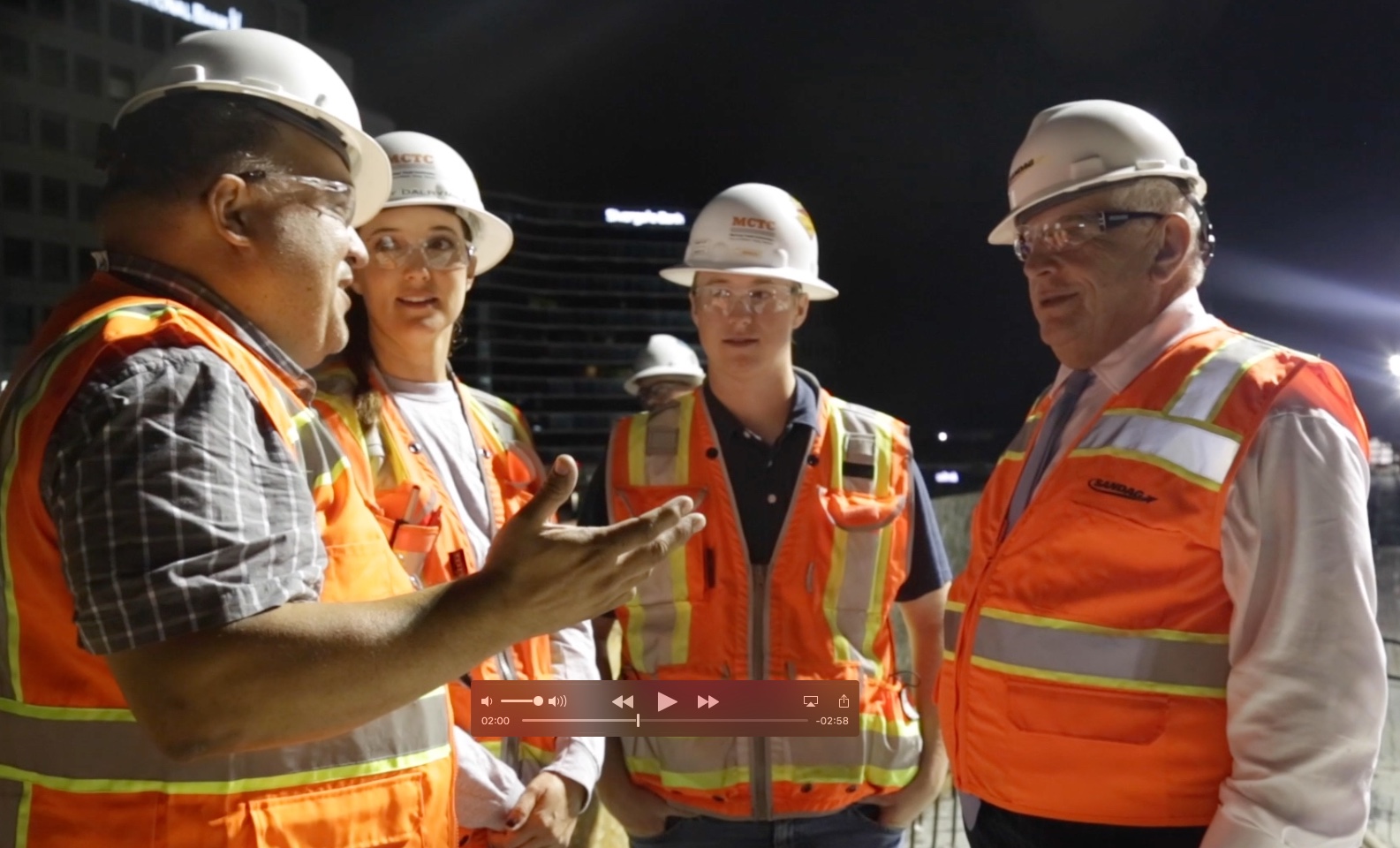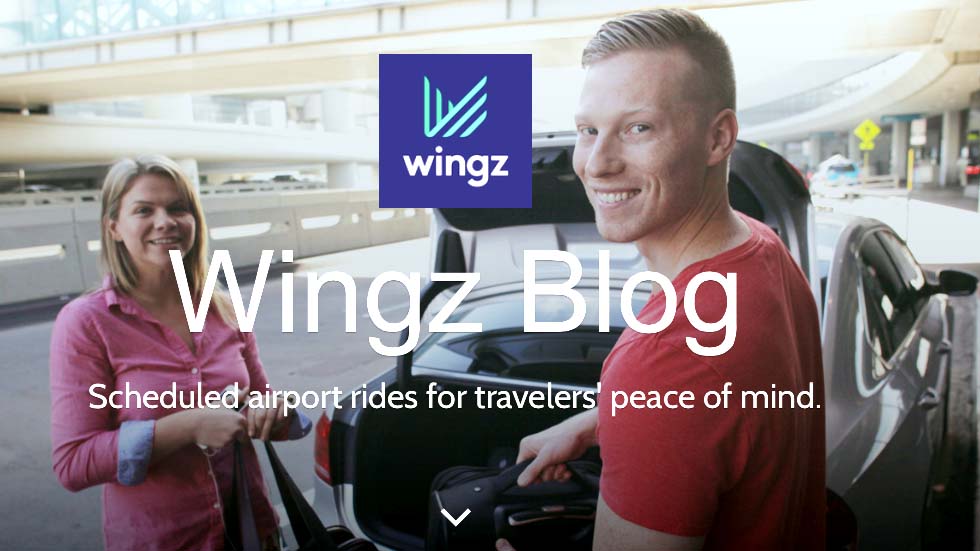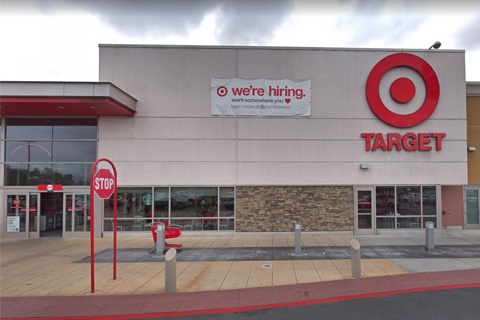Daily Business Report-Aug. 19, 2019
SANDAG Executive Director Hasan Ikhrata, right, speaks with the agency’s construction crew at the site of a concrete pour for the Mid-Coast Trolley Project at Genesee Avenue and La Jolla Village Drive. The pour formed the deck for the elevated Trolley bridge. (Scene from a SANDAG video)
SANDAG issues $335 million in bonds
to help finance Mid-Coast Trolley Project
SANDAG has issued $335 million in revenue bonds to help finance the construction of the Mid-Coast Trolley Project. The bonds will accelerate SANDAG’s receipt of an approximately $1.04 billion grant with the Federal Transit Administration under the Capital Investment Grant program.
“The bonds were issued at a low borrowing cost, which will allow us to maximize the use of federal dollars for the project,” said SANDAG Chair and Poway Mayor Steve Vaus. “The Mid-Coast Trolley project is the largest transit project in the San Diego region’s history, and once complete, San Diegans will feel the positive impact for generations to come.”
The Mid-Coast Trolley Project, which is currently under construction, will add nine new stations and extend San Diego Trolley service for 11 miles from Old Town to UC San Diego and University City. It is expected to begin service in late 2021.
The bonds were sold last week, with Wells Fargo Securities serving as lead underwriter.
“We are in the heart of the University community,” said SANDAG Executive Director Hasan Ikhrata, who on Thursday visited the site of a concrete pour for the Mid-Coast Trolley Project at Genesee Avenue and La Jolla Village Drive. “When this project is complete, residents, commuters, employers, students, and visitors will be able to travel to and from the University area and all the way down to the U.S Mexico border with ease.”
The University community, adjacent to the growing UC San Diego campus, is an employment hub and one of the most densely populated areas in the San Diego region. The Mid-Coast Trolley Blue Line will provide efficient public transit options, alleviating some of the traffic congestion for residents and commuters in the area.
____________________
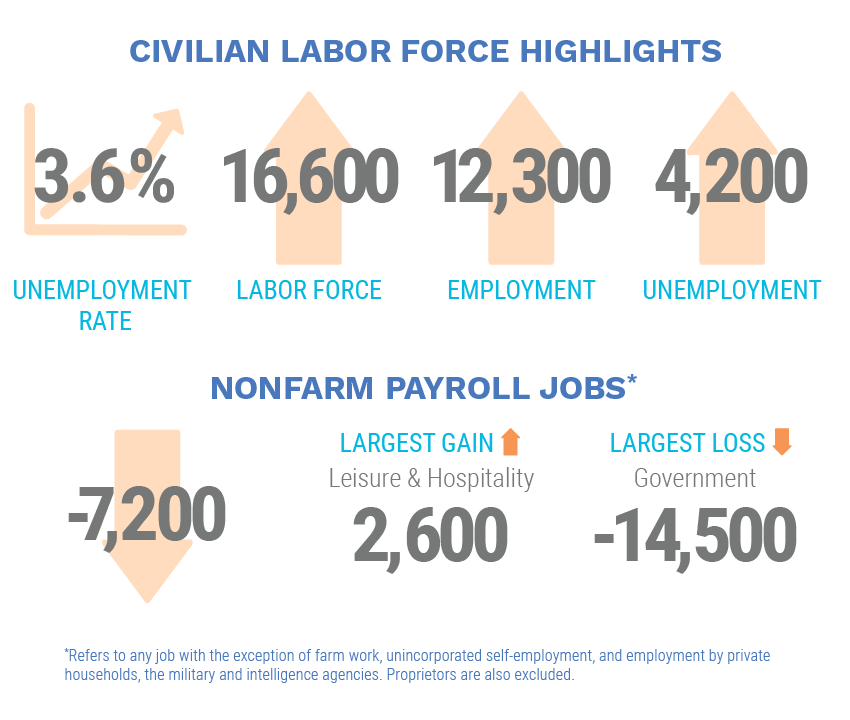
San Diego County Jobless rate in July: 3.6 percent
Nonfarm employment down 7,200 over the month; up 29,700 over the year
The unemployment rate in the San Diego County was 3.6 percent in July, up from a revised 3.3 percent in June 2019, and unchanged compared with the year-ago estimate of 3.6 percent, the state Employment Development Department reported. This compares with an unadjusted unemployment rate of 4.4 percent for California and 4.0 percent for the nation during the same period.
Between June 2019 and July 2019, total nonfarm employment decreased from 1,517,200 to 1,510,000, a loss of 7,200 jobs. Total farm employment remained unchanged.
Between July 2018 and July 2019, total nonfarm employment increased from 1,480,300 to 1,510,000, adding 29,700 jobs. Agricultural employment decreased by 500, from 9,500 to 9,000.
____________________
West Health’s Shelley Lyford appointed
to California’s Master Plan for Aging panel

Shelley Lyford, president and CEO of nonprofit, nonpartisan West Health and a commissioner on the California Commission on Aging, has been appointed to California’s Master Plan for Aging Stakeholder Advisory Committee, a group of civic leaders that will help guide how California addresses the health and human services and social support needs of its fast-growing senior population, which is expected to rise by four million over the next 10 years. Currently, more than 5.1 million seniors live in the Golden State.
The Stakeholder Advisory Committee includes a diverse group of community leaders, healthcare providers, employers, academic researchers and aging advocates that will advise the Cabinet Workgroup on Aging in the development of the Master Plan. California Health and Human Services Secretary Dr. Mark Ghaly announced the establishment of the advisory committee, and appointed Lyford to the group.
In June, Gov. Gavin Newsom signed an executive order calling for the completion of the Master Plan for Aging by Oct. 1, 2020 and mandated the formation of the advisory committee. According to the executive order, the Master Plan will “serve as a blueprint for state government, local government, private sector and philanthropy to implement strategies and partnerships that promote healthy aging and prepare the state for the coming demographic changes.”
____________________
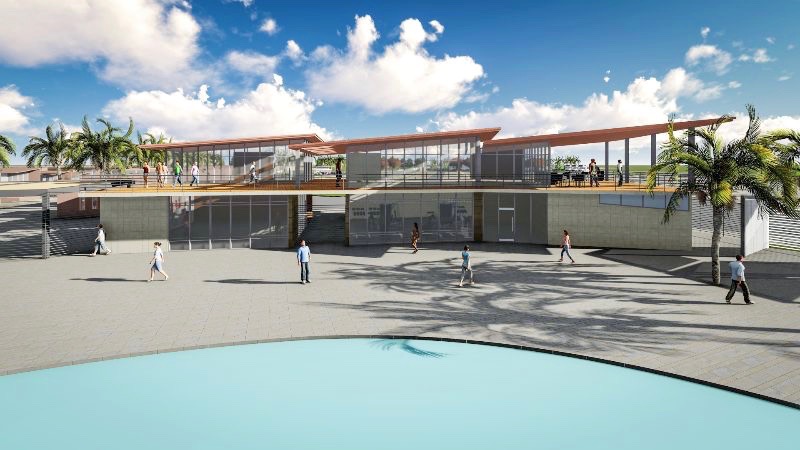
Port approves lease for Costa Vista RV
Park for Chula Vista Bayfront project
The Port of San Diego has unanimously approved the first lease for the Chula Vista Bayfront project – for a new destination RV park by Sun Communities Inc., an award-winning RV park developer and operator. With construction anticipated to begin in September, this sets the stage for the transformation of the Chula Vista Bayfront as envisioned by the Port, city of Chula Vista, and the community in the Chula Vista Bayfront Master Plan.
The Board of Port Commissioners on Aug. 13 granted a 66-year lease to Sun Chula Vista Bayfront RV LLC, a subsidiary of Sun Communities Inc., for its Costa Vista RV Resort. The resort will pave the way for the resort hotel and convention center, the anchor of the Chula Vista Bayfront Master Plan, as well as the future Sweetwater and Harbor Parks, and roadways.
Features of the Costa Vista RV Resort, to be built at E Street and Bay Boulevard, will include 246 sites with a mix of traditional RV stalls and park model stalls (park models are temporary cabin-like units that can be rented by the general public and provide temporary accommodations for recreation, camping or seasonal use).
The Costa Vista RV Resort will be the first major new component of the 535-acre Chula Vista Bayfront Master Plan.
____________________
USD joins 3 other universities in program
to support human trafficking survivors
Four universities have announced that they will collaborate in the 2019–20 school year using design thinking methodologies to explore new ways to meet the needs of human trafficking survivors. Students and faculty from the law schools at the University of San Diego, University of Arizona, Duke University and Harvard University are partnering to explore new legal solutions, conduct in-depth research and develop community resources and possible policy changes to support human trafficking survivors.
Jamie Beck, president and managing attorney of Free to Thrive, will join the collaboration as a community partner. Free to Thrive is a San Diego based nonprofit organization that provides legal services and connections to other support to human trafficking survivors.
____________________
Aspiriant and Big Brothers Big Sisters
to sponsor financial literacy workshop for youth
Aspiriant and Big Brothers Big Sisters of San Diego County are teaming together for a community financial literacy workshop on Tuesday from 10 a.m. to 12:30 p.m. at the BBBS office.
Aspiriant professionals will present an interactive learning session where high school-aged “Littles” will learn important personal finance topics like budgeting, saving, credit, debit and an introduction to investments. The “Littles” will enjoy games, lunch and receive a take-home booklet. These are important concepts that aren’t often taught in high school and Aspiriant is able to support the important initiative in the community.
“We are thrilled to partner with Aspiriant to educate our Littles on the importance of planning for their bright futures,” said Talia Hazard, director of marketing and events for Big Brothers Big Sisters of San Diego County. “Financial literacy is critical to successfully navigating the world and we are so grateful to the Aspiriant team for helping equip the children in our program with the tools required to prepare for their next steps.”
____________________
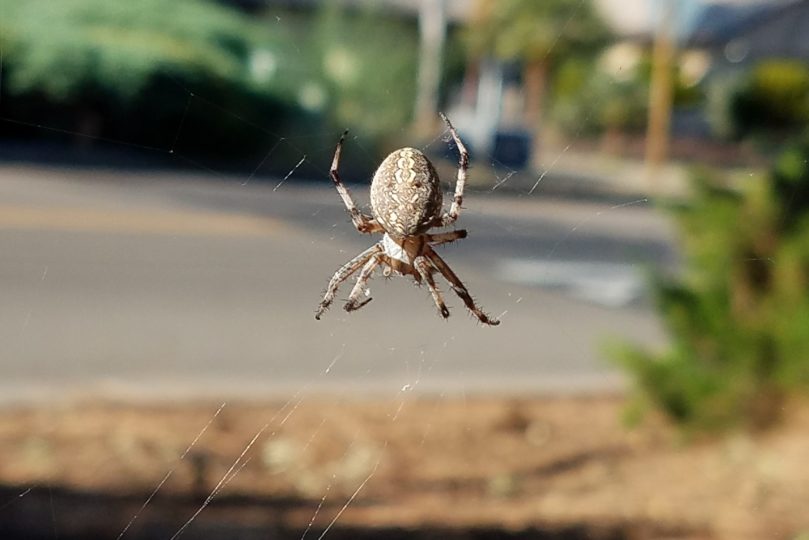
It’s crazy spider dance time; Orb weaver season is back
County News Center
They’re big. They’re scary looking. And they spin enormous, circular webs that can stretch between trees, from a tree to your house, or your house to your car.
It’s orb weaver spider time again in San Diego County—and this year could yield a bumper crop.
Stumbling into an orb weaver web is an unmistakably creepy feeling. You could be hiking around the neighborhood, working in the yard, or walking out to the car.
Suddenly, you’re smacked right in the face, your hair, your arm or other exposed bit of skin by a large, sticky strand of web! Your spider-senses scream. You flail, stumble, try to peel the web away, and as passersby stare you’re doing what County supervising vector ecologist Chris Conlan calls “the crazy spider dance.”
Conlan, who has loved insects, spiders and critters since he was a kid, has been the County’s most visible “bug guy” for years as part of the County’s Vector Control Program.
Conlan said this week that county residents could see more orb weavers this year than they have in years. He said that’s because spiders—including orb weavers— have more little bugs to eat this year because we had a lot of rain, which created more vegetation and insects overall.
“So, you’re probably going to be running into a lot of spider webs very soon, if you haven’t already,” Conlan said.

